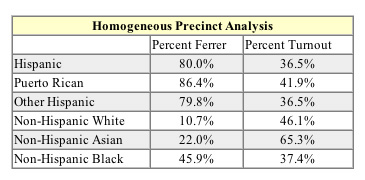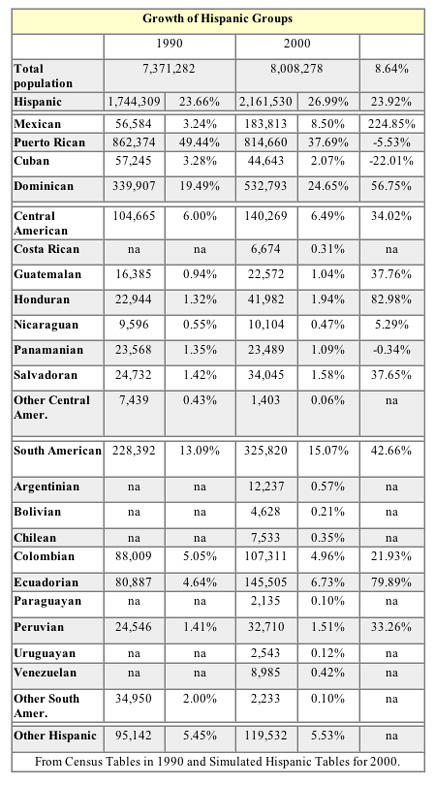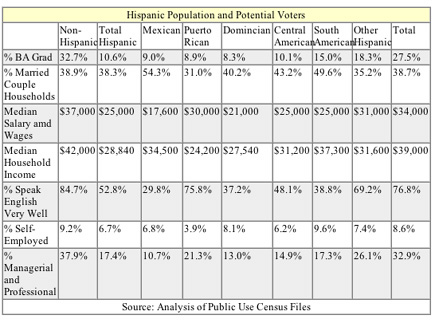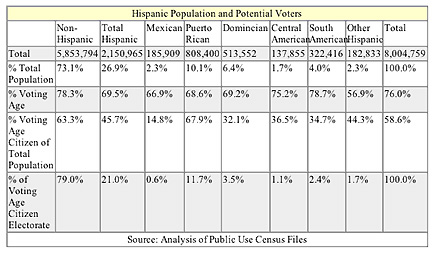Fernando Ferrer was the first candidate of Hispanic descent to run with major party backing for the office of mayor of New York City, and when he lost by a large margin, there was a general consensus among journalists: Ferrer, they said, did poorly among every ethnic group, even -- relatively speaking –- his own.
Some commentators sought to explain this by noting that “Hispanic” no longer means just Puerto Ricans, or even just Puerto Ricans and Dominicans. Hispanic New Yorkers come from many different countries now. Others pointed out that Bloomberg’s polling of voters was very vigorous and very specific, but that it was not based on their ethnic origins. Thus, it was possible to ask seriously whether the mayoral election signaled a new phase in New York City politics -- the beginning of the end of ethnic politics.
There was just one problem with all these explanations and conclusions -- they were based on an inaccurate consensus.
No major news organizations did their own polling; their conclusions about Ferrer’s support was based on an unconventional exit poll.
Now more data are available, including complete voting returns for all 6,000 of New York City's election district, as well as a recent exit poll among immigrants. It turns out that the vast majority of Hispanic voters did in fact choose Ferrer -– at least 80 percent. This demonstrates not just that ethnic politics is alive and well in New York City, but that, as diverse as they are, Hispanics in New York share much in common.

An analysis of voting preference in homogeneous election districts (those with high proportions of a specific ethnic group), reveals that Ferrer did very well among all types of Hispanics.
So why did he lose so badly?
First, turnout was markedly low in Hispanic areas. Second, other groups did not vote for him in high numbers; In areas of high concentrations of African Americans, he received less than half the vote, while he got 22 percent of the Asian vote and only 10 percent of non-Hispanic white voters.
A recently released survey by the New York Immigration Coalition produced similar results.
Characteristics Of Hispanic New Yorkers

The Hispanic population in New York City is growing rapidly, and becoming more diverse. The Puerto Rican population, which still constitutes the largest Hispanic group in the city, is diminishing. Mexicans have experienced explosive growth. Other groups have grown by at least a third.
When one examines the social and economic position of Hispanics in New York City it is plain that though there are some variations among the groups, they do face similar economic challenges.

They are less educated, earn less, have lower household incomes than other New Yorkers. A smaller fraction of them speak English "very well." They also are somewhat less likely to be self-employed and much less likely to be employed in managerial and professional occupations.
It is difficult to call them a powerful voting bloc just yet, though, since most of them cannot vote. They are either under 18 or non-citizens.

The Hispanics as a group compose about 27 percent New York City's population, but only 21 percent of citizens of voting age population. Indeed, while for non-Hispanics about two-thirds of the population are voting age citizens, for the Hispanic groups the percent is less than half; only about 15 percent of Mexicans in New York are citizens of voting age.
Andrew A. Beveridge has taught sociology at Queens College since 1981, done demographic analyses for the New York Times since 1993, and been in charge of Gotham Gazette's demographics topic page since 2000. The opinions expressed are his alone.Â